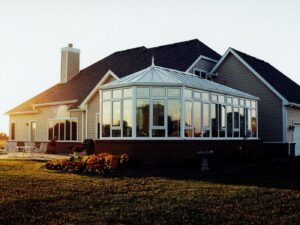We use a lot of 3-letter acronyms in the sunroom industry, but one you might hear bandied about the most is OSB, which stands for Oriented Strand Board. Since we use this material so often, we figured we’d give you the 101 on OSB and break it down to the basics: what it is, how we use it, and why it’s useful. So strap in for your OSB orientation.
At LivingSpace, OSB is one of the main components we use to make our Eco Green panels. These panels are incredibly versatile – we use them to build roofing, decking, knee wall panels, and more. Eco Green panels are a compound building element, with a thick layer of dense foam sandwiched between two pieces of OSB, for a rigid structural piece with excellent thermal properties that helps insulate the LivingSpace sunroom. OSB is one of the most popular wood products in construction, and it’s used by a range of craftsmen working on anything from do-it-yourself jobs to professional projects.
Similarities: OSB and plywood
The best way to explain OSB is by comparing it to another commonly used wood product: plywood. OSB and plywood are fairly similar in terms of functionality and structure, and they’re both installed onto roofs, walls, and floors. Both products have similar structural performance measurements and standards. Additionally, OSB and plywood are both durable under a variety of different exposure settings, including Exposure 1, Exposure 2, and Exterior. The Exposure 1 classification is the most important, as it accounts for 95% of all structural panels. An Exposure 1 classification says that the wood used to build sub-floors and sheathing panels can be open to the elements during construction without compromising the structural properties of the panel.
Differences: OSB and plywood
On the other hand, plywood is made from larger, slower growing trees like Douglas fir or redwood. The panel is constructed by shaving the trees into thin layers of wood into “plies.” This process leaves fragments of the tree unused. Plies are bonded together through adhesive to make the structurally sound building material used in construction. Wax and binders waterproof plywood similarly to the way they waterproof OSB.
Why LivingSpace uses OSB
LivingSpace, among a majority of other manufacturers, chooses OSB over plywood because of the differences. OSB is the structural future, and it has slowly taken command over plywood, controlling 66% of the market. Moreover, using this type of wood product reduces LivingSpace’s environmental footprint, as OSB uses every possible inch of the fast-growing trees it is made from. Lastly, OSB is the economical choice, as it’s manufactured at a lower cost compared to plywood. LivingSpace is committed to working with the best products to create the market’s preeminent sunroom. OSB is and will likely continue to be the construction industry’s leading wood product.



